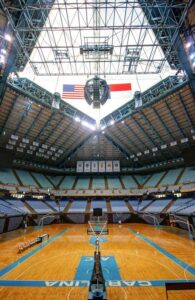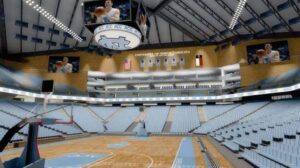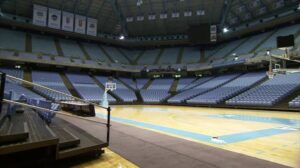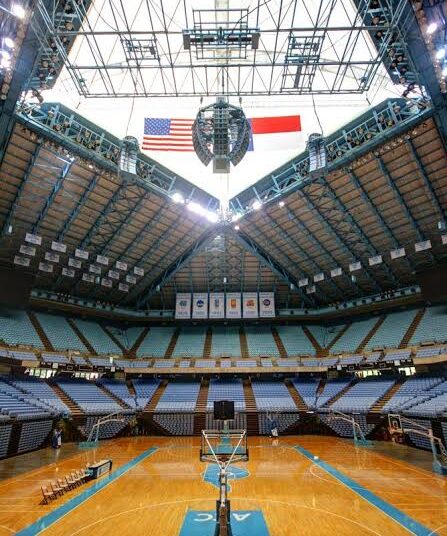🚨 BREAKING NEWS: North Carolina Tar Heels Unveil $1.3 B Renovation to Dean E. Smith Center – Redefining the Future of College Basketball 🚨
In a landmark announcement that rocked the world of collegiate athletics, the University of North Carolina at Chapel Hill has officially unveiled a $1.3 billion renovation and transformation plan for the iconic Dean E. Smith Center, marking the most ambitious overhaul in NCAA history. This all-encompassing vision promises to reshape the stadium into a state‑of‑the‑art basketball cathedral, reaffirming UNC’s commitment to its Tar Heels legacy—and the future of college basketball itself.
—
1. A Historic Investment in Tradition
The Dean Dome has stood as a symbol of Carolina pride since it first opened its doors on January 18, 1986 . While upgrades—including new video and ribbon boards, locker room improvements, and accessible seating—have been made over decades , this latest investment dwarfs all that came before. At $1.3 billion, it becomes the largest single‑arena project in NCAA history, underscoring not just flashy bells and whistles, but a deep institutional commitment to excellence.

—
2. Key Features of the $1.3 B Makeover
Here’s what fans, alumni, and players can expect from this transformation:
Premium Seating Expansion – A 20% increase in luxury suites and club-level options, responding to long-standing demands for top-tier amenities .
Modernized Concourse & Amenities – Wider concourses, modern restrooms, expanded concessions, and integrated social spaces to foster vibrant game-day energy.
Enhanced Fan Experience – Seamless connectivity with in-arena Wi‑Fi, a cutting-edge centralized scoreboard, and immersive visual tech for every seat.
Accessibility & Inclusivity Upgrades – New accessible seating zones equipped with dedicated ramps, elevators, and support services.
Athlete-Centric Facilities – Enlarged locker rooms, hydrotherapy zones, advanced weight and training areas, plus reinforced recovery spaces.
Mixed-Use Additions – A surrounding complex with retail outlets, restaurants, office spaces, and gathering plazas to energize the venue year-round .
Parking & Transit Infrastructure – Expanded parking capacity and synergy with Chapel Hill Transit, leveraging off-campus lots and shuttles to alleviate traffic congestion .
Though some elements borrow from off‑campus arena proposals—including rooftop entertainment spaces and shared usage with women’s basketball, volleyball, gymnastics, and wrestling teams—the Smith Center itself remains the project’s centerpiece .

—
3. Why This Was Necessary
Behind the high price tag lie structural realities and shifting fan expectations:
Aging Infrastructure – The roof at the Smith Center alone carries a replacement cost between $80–100 million, according to Chancellor Lee Roberts, even before factoring in other upgrades .
Limited Premium Seating – The original design included permanent permanent seating rights for lifetime donors, hindering modern revenue-generating strategies. A renovation resets these constraints while preserving donor relationships .
Revenue Imperative – In an era of costly coaching contracts, player recruitment demands, and escalating facilities costs, new premium and club offerings promise critical revenue upside .
Fan Experience Gap – With outdated concourses and amenities falling behind peer institutions, there was growing urgency in respecting fan expectations for facility quality and ambience .
Chancellor Roberts noted, “The status quo is not an option. A new roof doesn’t fix narrow concourses, limited premium seating, or lack of retail gathering spaces” .
—
4. The Big Reveal & Timeline
Although the university spent $217,000 on a feasibility study conducted by Populous Architects—with deliverables due by July 31, 2024 —no final decision was announced at that time; UNC was weighing on-campus renovation versus off-campus new build . The $1.3 billion renovation confirmed this month marks a definitive choice: transform the existing Smith Center rather than relocate.
The project rollout will begin with ground‑breaking (envisioned in 2026), multiple construction phases to keep the arena operational through each basketball season, and completion expected in early 2032—coinciding with UNC’s campus master plan timeframe .

—
5. Community & Student Response
Reactions across campus and Chapel Hill have been mixed:
Excitement – Many alumni, students, and long-time fans are thrilled, calling it a rebirth for a facility that shaped Tar Heels lore.
Concerns – Some faculty and neighborhood residents worry about construction disruptions and loss of certain green spaces around campus .
Balanced Optimism – Supporters believe the mixed-use development (retail, plazas, transit upgrades) offsets negative impacts by anchoring campus life around more functional, bustling spaces.
Students are especially interested in how shared facilities—tied to both men’s and women’s teams—might enhance equity, cohesion, and resource optimization .
—
6. A Legacy Project
For UNC basketball, the Dean Dome has hosted unforgettable moments—from the electrifying debut against Duke in 1986, to hosting the 1987 U.S. Olympic Festival, and more than 450 wins and fewer than 100 losses over its history . But aspirations have grown deeper: alumni are looking for a future where Coach Roy’s court shines alongside modern hospitality, premium amenities, and a court designed for a global NCAA brand.
The $1.3 billion renovation is more than a facelift—it’s a renegotiation of the past, present, and future, one that positions UNC as a leader in collegiate athletics in quality, revenue, equity, and fan experience.
—
In Summary:
This sweeping renovation of the Dean E. Smith Center reaffirms UNC’s dual commitment to preserving storied tradition and boldly redefining collegiate athletic facilities. With premium revenue streams, fan-centric amenities, inclusive athletic spaces, and mixed-use vibrancy, Chapel Hill is writing a new chapter—one where Blue Heaven will thrive for decades to come.













